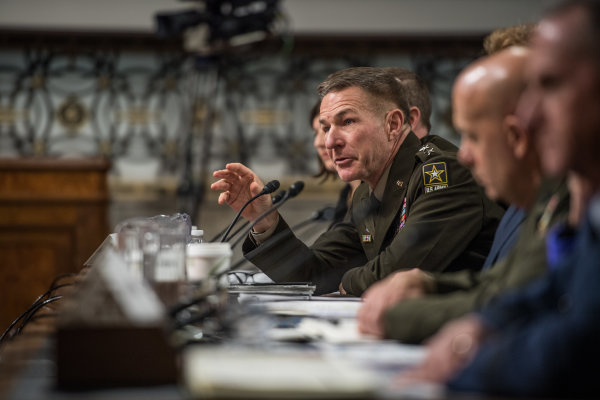

While artificial intelligence and autonomous capabilities remain critical subjects for future military endeavors, the Army’s top officer is more interested in optionally-manned systems rather than totally unmanned.
Army Chief of Staff James McConville said on Tuesday that’s he’s “more into the minimally manned capability” and doesn’t “like to say it’s either-or” when it comes to unmanned and manned capabilities.
McConville’s logic is simple: while the idea of a totally unmanned system may work in some scenarios, you’ll probably still want to have at least one person inside any expensive battlewagon just in case things go sideways.
“If we’re going to move a large amount of troops — you know, a Ranger unit or something like that going in — I don’t necessarily see us putting them in an aircraft and having no one up front, you know?” he said at an Atlantic Council event. “You’ve got 30 Rangers going somewhere and they look up and there’s no one there? You know, like ‘Good luck.’ I don’t see that.”
The Army has been pushing forward on the idea of self-operating systems, like the semi-autonomous Small Multipurpose Equipment Transport (SMET) — essentially a self-driving pack mule. And Future Vertical Lift, one of the service’s six modernization priorities, demands that the defense industry develop vehicles that can partner with unmanned systems and perform unmanned operations if necessary.
At the very least, autonomous technology could help reduce how many troops are needed to operate each system. For example, the pilotless UH-60 Black Hawk would give a pilot inside the ability to toggle between levels of autonomy, freeing them up for other tasks.
As Igor Cherepinsky, Sikorsky’s Director of Autonomy, told Military.com, the goal is to “augment the pilots, not replace the pilots.”
When it comes to ground vehicles, McConville said, you’ll probably still need someone available to help navigate things the autonomous vehicle has trouble with.
“When you look at autonomous vehicles, they have a hard time making left hand turns in traffic,” he said. “So you may need to be attentive for that time … Or if you’re approaching a difficult thing, you might need to have one person.”
